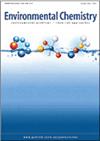空气-水界面上糖类的富集:海面微层和泡沫的定量比较
IF 2.3
4区 环境科学与生态学
Q3 CHEMISTRY, ANALYTICAL
引用次数: 0
摘要
糖类对海洋中溶解的有机碳有很大贡献,并且在海洋表面富集。在这项研究中,我们证明了糖在持久的白浪泡沫中比在海面上更丰富。因此,预计空气-水界面气泡的成熟将增强海洋表面有机物的富集,并最终在海洋表面气泡破裂时形成的海洋喷雾气溶胶中富集。基本原理:有机物在海洋表面积聚。在此,我们首次对持久性白沫中溶解糖的富集进行了定量评估,并将这种富集与海洋气溶胶参考池(MART)中浮游植物爆发的9天中尺度实验中海面微层(SSML)的富集进行了比较。方法直接定量游离单糖,温和酸水解后测定总糖,以寡糖/多糖组分作为总糖与游离单糖的差异。结果总糖对溶解有机碳(DOC)的贡献较大,分别占海水的13%、SSML的27%和泡沫的31%。中位富集因子(EFs),以SSML或泡沫中糖类相对于钠的浓度与海水的浓度之比计算,在SSML中为1.7 - 6.4,在泡沫中为2.1-12.1。基于中间值EFs,木糖醇、甘露醇、葡萄糖、半乳糖、甘露糖、木糖、焦糖、鼠李糖和核糖在泡沫中的含量高于SSML。糖的最大EFs与高叶绿素水平一致,表明在浮游植物大量繁殖期间,海洋表面糖的富集增加。海洋泡沫中有机物的富集程度高于SSML,表明表面活性有机化合物在持久性气泡膜表面的富集程度越来越高。这些发现有助于解释海洋有机物如何在海洋表面气泡破裂产生的海洋喷雾气溶胶中变得高度富集。本文章由计算机程序翻译,如有差异,请以英文原文为准。
Enrichment of saccharides at the air–water interface: a quantitative comparison of sea surface microlayer and foam
Environmental context Saccharides contribute substantially to dissolved organic carbon in the ocean and are enriched at the ocean surface. In this study, we demonstrate that saccharides are more enriched in persistent whitecap foam compared to the sea surface. The maturation of bubbles at the air–water interface is thus expected to enhance the enrichment of organic matter at the ocean surface and ultimately in the sea spray aerosol that forms when bubbles burst at the ocean surface. Rationale Organic matter accumulates at the ocean surface. Herein, we provide the first quantitative assessment of the enrichment of dissolved saccharides in persistent whitecap foam and compare this enrichment to the sea surface microlayer (SSML) during a 9 day mesocosm experiment involving a phytoplankton bloom generated in a Marine Aerosol Reference Tank (MART). Methodology Free monosaccharides were quantified directly, total saccharides were determined following mild acid hydrolysis and the oligo/polysaccharide component was determined as the difference between total and free monosaccharides. Results Total saccharides contributed a significant fraction of dissolved organic carbon (DOC), accounting for 13% of DOC in seawater, 27% in SSML and 31% in foam. Median enrichment factors (EFs), calculated as the ratio of the concentrations of saccharides relative to sodium in SSML or foam to that of seawater, ranged from 1.7 to 6.4 in SSML and 2.1–12.1 in foam. Based on median EFs, xylitol, mannitol, glucose, galactose, mannose, xylose, fucose, rhamnose and ribose were more enriched in foam than SSML. Discussion The greatest EFs for saccharides coincided with high chlorophyll levels, indicating increasing ocean surface enrichment of saccharides during phytoplankton blooms. Higher enrichments of organic matter in sea foam over the SSML indicate that surface active organic compounds become increasingly enriched on persistent bubble film surfaces. These findings help to explain how marine organic matter becomes highly enriched in sea spray aerosol that is generated by bursting bubbles at the ocean surface.
求助全文
通过发布文献求助,成功后即可免费获取论文全文。
去求助
来源期刊

Environmental Chemistry
环境科学-分析化学
CiteScore
4.50
自引率
0.00%
发文量
0
审稿时长
2.7 months
期刊介绍:
Environmental Chemistry publishes manuscripts addressing the chemistry of the environment (air, water, earth, and biota), including the behaviour and impacts of contaminants and other anthropogenic disturbances. The scope encompasses atmospheric chemistry, geochemistry and biogeochemistry, climate change, marine and freshwater chemistry, polar chemistry, fire chemistry, soil and sediment chemistry, and chemical aspects of ecotoxicology. Papers that take an interdisciplinary approach, while advancing our understanding of the linkages between chemistry and physical or biological processes, are particularly encouraged.
While focusing on the publication of important original research and timely reviews, the journal also publishes essays and opinion pieces on issues of importance to environmental scientists, such as policy and funding.
Papers should be written in a style that is accessible to those outside the field, as the readership will include - in addition to chemists - biologists, toxicologists, soil scientists, and workers from government and industrial institutions. All manuscripts are rigorously peer-reviewed and professionally copy-edited.
Environmental Chemistry is published with the endorsement of the Commonwealth Scientific and Industrial Research Organisation (CSIRO) and the Australian Academy of Science.
 求助内容:
求助内容: 应助结果提醒方式:
应助结果提醒方式:


